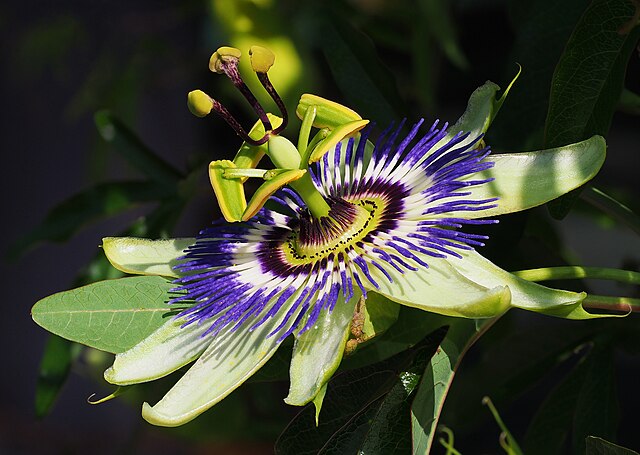Top Qs
Timeline
Chat
Perspective
Passiflora caerulea
Species of flowering plant in the passion flower family From Wikipedia, the free encyclopedia
Remove ads
Passiflora caerulea, the blue passionflower,[1] bluecrown passionflower[2] or common passion flower, is a species of flowering plant native to South America that has been introduced elsewhere.
It forms a vigorous, deciduous or semi-evergreen tendril-bearing vine growing to 10 m (33 ft) or more. Its leaves are palmately lobed, and its fragrant flowers are blue-white with a prominent fringe of coronal filaments in bands of blue, white, yellow, and brown. The ovoid orange fruit grows to 6 cm (2 in) across.
The fruit is edible, but is sometimes described as having an unpalatable or unpleasant flavour. In South America, the plant is known for its medicinal properties, and is used by both the Toba and the Maka peoples.
Remove ads
Description

Passiflora caerulea is a woody vine capable of growing to 25 metres (82 ft) high where supporting trees are available.[3] The leaves are alternate, palmately five-lobed (sometimes three, seven, or nine lobes), and are up to 10 centimetres (4 in) in length while being linear-oblong shaped.[4] The base of each leaf has a flagellate-twining tendril 5–10 cm (2–4 in) long, which twines around supporting vegetation to hold the plant up.[3]
The flower is complex, about 10 cm (4 in) in diameter,[4] with the five sepals and petals similar in appearance, whitish in colour, surmounted by a corona of blue or violet filaments, then five greenish-yellow stamens and three purple stigmas.[3] The fruit is an oval orange-yellow berry, 6 cm (2+1⁄4 in) long by 4 cm (1+1⁄2 in) in diameter, containing numerous seeds.[3]
Chemical constituents
Compared to P. incarnata, this plant contains higher amounts of the MAO-inhibitor harmine.[5]
Remove ads
Etymology
The specific epithet caerulea means "blue" and refers to the blue coronal filaments.[6]
Cultivation
Passiflora caerulea is widely cultivated as a wall-climber or as groundcover. It is a hardy species, able to survive winter temperatures as low as −10 °C (14 °F),[7] although it requires a sheltered position facing south or west (in the Northern Hemisphere). It can become invasive, the twining shoots constantly appearing unless eradicated. It is the only Passiflora species that volunteers in California. It has gained the Royal Horticultural Society's Award of Garden Merit.[8]
Cultivars

A number of cultivars have been produced from the species:
- 'Chinensis' (corona filaments paler blue)
- 'Constance Elliott' was raised by Lucombe, Pince & Co in Exeter, Great Britain in 1884. It has pure white, fragrant flowers; not as free-flowering as many other clones. It has also won the Award of Garden Merit from the Royal Horticultural Society.[9]
- 'Pierre Pomie', a pale pink flower form
Uses
The fruit is edible to humans when ripe, but its flavour has been described as bland,[10] undesirable[11] or insipid.[12] If allowed to fully ripen in a warm climate and fall naturally from the vine, it has a mild blackberry flavour,[13] though with a lower sugar content than commonly eaten species.[citation needed]

A tea can be made of the flower or leaves; but the leaves contain tetraphyllin B and epi-tetraphyllin B, cyanogenic glycosides that liberate hydrogen cyanide when activated by enzymes. It is possible to boil away most of the cyanide.[12]
In South America, the plant is known for its medicinal uses. It is used in both herbal tea and dietary supplements, as well as in marmalades, ice creams, syrups and beverages.[11][14] It is also used by the indigenous Argentinian Toba and Maka people.[11][14]
Passiflora caerulea is sometimes used as a rootstock, to which is grafted a scion of the edible P. edulis.[15]
Remove ads
In culture
The passion flower is the national flower of Paraguay. Its intricate structure has generated Christian symbolism, each part representing a different part of the Passion of Christ.
Gallery
- Flower
- Fruit
- Flower
- 'Constance Elliot', a white flowered cultivar
- 'Pierre Pomie', a pale pink flowered cultivar
- Peculiarity: two fused filaments force anthers upwards, displaying pollen beds otherwise not visible from this perspective.
- Flower
- Seeds, the red gel-like substance around them removed
References
External links
Wikiwand - on
Seamless Wikipedia browsing. On steroids.
Remove ads










